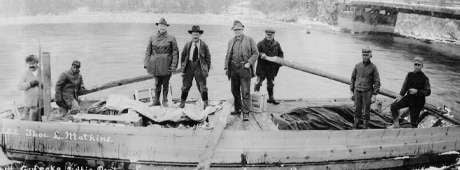No products in the cart.
From Scow to Sweep Boat

A Rafting Evolution
By Ray Brooks
In late July 2000, it was raining lightly on Boundary Creek’s steep wooden launch ramp of the Middle Fork Salmon as our group started loading our rafts. When I was an apprentice Middle Fork rafting guide back in 1972, I had been taught that rafts always should be belayed down this steep ramp with a long climbing rope. It had to be wrapped once around a crossbeam at the top of the ramp and the belayer had to be seated and have gloves on “just in case.” Usually, boats were pulled down the ramp by rafters but towards the bottom, the rope and belayer were sometimes needed to keep the raft in check.
As we loaded our first raft on the ramp, a group of guides waited impatiently for “the amateurs,” so they could then put their boats in the river. As I helped tug my raft down the ramp, the sprinkle of rain on the well-polished wood of the ramp caused the raft to start sliding. Our belayer had too much slack in the rope and although he slowed the boat, he got jerked around a bit. The waiting river guides had a good laugh at our display of ineptitude. Our other two boats went down the ramp smoothly and then the guides backed up their large trailer and off-loaded their huge sweep boat. Our rafts, which had been mostly unloaded before we launched them, weighed about two hundred pounds, while the twenty-eight-foot-long sweep boat was fully loaded and probably weighed about two tons. Of course, a guide belayed it with a climbing rope, but he also had a little slack in the rope.
About halfway down the launch ramp, where it gets much steeper, the heavy sweep boat suddenly took off sliding on the wet wood like an aquatic locomotive. The slightly slackened belay rope came tight and snapped with a loud crack. Wisely, the river guides jumped off the ramp as the sweep boat thundered past, totally out of control. Nobody was at the bottom of the launch ramp where the boat hit the water at thirty to fifty miles per hour with a mighty splash and promptly began a solo journey down the Middle Fork. Two guides made Tarzan dives into the water and one managed to catch and climb onto the sweep boat before it hit fast water. He was just able to get it into the last vestige of calm water in the hole below the ramp, and saved the day for the outfitting company. The rest of us were too stunned by all this to smile at the belaying mistake.
This content is available for purchase. Please select from available options.
Purchase Only
Purchase Only


2 Responses to From Scow to Sweep Boat
Ivan Nichols -
at
In the interest of posterity and accuracy I’d like to offer a few corrections:
1. John N. McKay first began using bateau style boats and did not begin using flat-boats until much later. They first graced the Salmon in 1883.
2. Guleke began freighting on the Salmon in 1896/97
3. George Sandilands drowned at Pine creek rapids in the summer of 1907 rather than 1897
4. The road reached Shoup in 1917
5. There were 6 railroad surveys: 1870, 1872, 1889, 1905, 1908, 1909-10
6. The first person to run the river aboard a flat-boat from Salmon City to Riggins was Henry “Harry” Guleke in 1901. Prior to this he had only been down river as far as Crooked creek.
7. The River of No Return 1977 is not an accurate source of information being wholly unresearched
Ray Brooks -
at
I’m currently on vacation and far from my research material, so I will only reply to item #7. in the above comments. I find Mr. NIchols comment that River of No return by Conley & Carey “is not an accurate source of information” to be puzzling, at best.
Cort Conley, an Idaho historian, author and boatman, provides all sorts of reference citations in a book that I’ve seen nothing but praise for. I am unable to find any criticism for River of No Return, other than what Mr. Nichols offers.